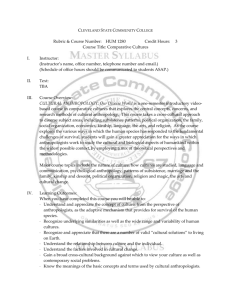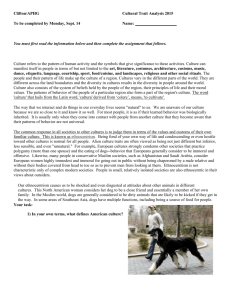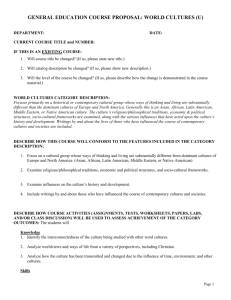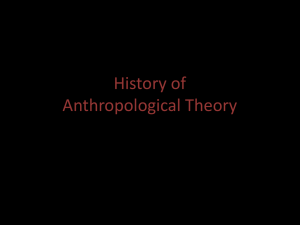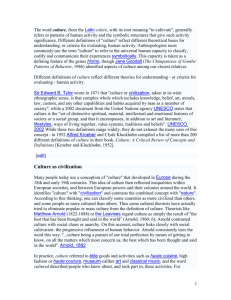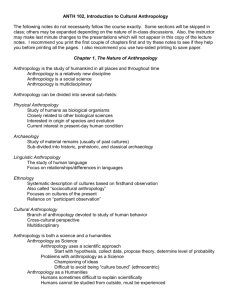ant.101.outline.f2010
advertisement
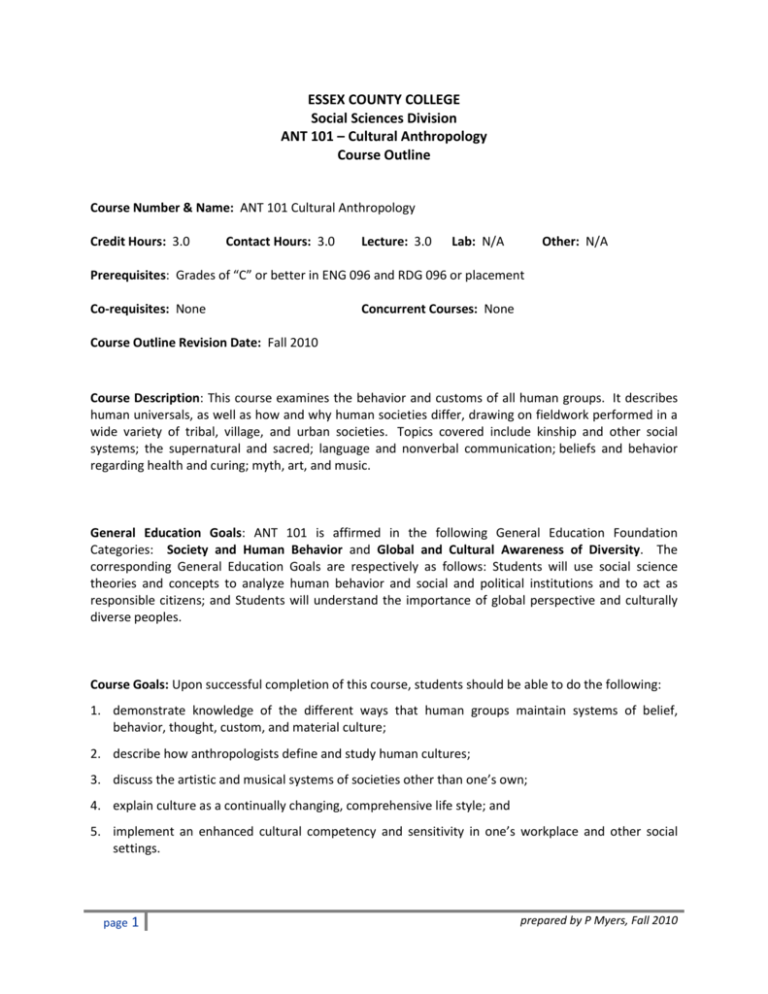
ESSEX COUNTY COLLEGE Social Sciences Division ANT 101 – Cultural Anthropology Course Outline Course Number & Name: ANT 101 Cultural Anthropology Credit Hours: 3.0 Contact Hours: 3.0 Lecture: 3.0 Lab: N/A Other: N/A Prerequisites: Grades of “C” or better in ENG 096 and RDG 096 or placement Co-requisites: None Concurrent Courses: None Course Outline Revision Date: Fall 2010 Course Description: This course examines the behavior and customs of all human groups. It describes human universals, as well as how and why human societies differ, drawing on fieldwork performed in a wide variety of tribal, village, and urban societies. Topics covered include kinship and other social systems; the supernatural and sacred; language and nonverbal communication; beliefs and behavior regarding health and curing; myth, art, and music. General Education Goals: ANT 101 is affirmed in the following General Education Foundation Categories: Society and Human Behavior and Global and Cultural Awareness of Diversity. The corresponding General Education Goals are respectively as follows: Students will use social science theories and concepts to analyze human behavior and social and political institutions and to act as responsible citizens; and Students will understand the importance of global perspective and culturally diverse peoples. Course Goals: Upon successful completion of this course, students should be able to do the following: 1. demonstrate knowledge of the different ways that human groups maintain systems of belief, behavior, thought, custom, and material culture; 2. describe how anthropologists define and study human cultures; 3. discuss the artistic and musical systems of societies other than one’s own; 4. explain culture as a continually changing, comprehensive life style; and 5. implement an enhanced cultural competency and sensitivity in one’s workplace and other social settings. page 1 prepared by P Myers, Fall 2010 Measurable Course Performance Objectives (MPOs): Upon successful completion of this course, students should specifically be able to do the following: 1. Demonstrate knowledge of the different ways that human groups maintain systems of belief, behavior, thought, custom, and material culture: 1.1 describe how cultures worldwide mark off important transitions with ritual and ceremony, providing specific examples; 1.2 describe how cultures worldwide maintain systems of belief and behavior concerning the sacred, supernatural and afterlife, providing specific examples; 1.3 describe how cultures worldwide maintain norms of appropriate behavior; 1.4 identify how cultures other than one’s own maintain systems of communication by language and body language, providing specific examples; and 1.5 identify systems of tool use, design, and architecture in use in cultures other than one’s own, providing specific examples 2. Describe how anthropologists define and study human cultures: 2.1 identify and describe the professional activities of anthropologists; and 2.2 observe and describe cultural behavior in a role-play situation 3. Discuss the artistic and musical systems of societies other than one’s own: 3.1 describe forms of art and design employed by cultures other than one’s own; 3.2 identify and discuss world musical styles 4. Explain culture as a continually changing, comprehensive life style: 4.1 discuss how culture changes continually so the “past is a foreign country;” and 4.2 discuss current cultural innovations in one’s own and other societies 5. Implement an enhanced cultural competency and sensitivity in one’s workplace and other social settings: 5.1 identify newly discovered cultural practices of peers that were revealed in class exercises; and 5.2 discuss and implement methods of relating to persons of other cultures consuming one’s services while working in a business, educational, health care, social service or other workplace setting Methods of Instruction: Instruction will consist of, but not be limited to, a combination of lecture, class discussion, demonstrations and exercises, field trips and audiovisual and Web media. Specific choice of instructional technology is left to the discretion of the instructor. Outcomes Assessment: Quiz and exam questions (if applicable) are blueprinted to meet course objectives. Logs, reaction papers, and projects are evaluated according to checklist rubrics, which are made available to students prior to their completion of the assignment. Data will be analyzed to give direction for the improvement of instruction, viability of assignments, and relevancy of assigned readings or media. page 2 prepared by P Myers, Fall 2010 Course Requirements: All students are required to: 1. Maintain regular and prompt attendance and be active in class discussion. 2. Complete all scheduled assignments, exams, and quizzes on time or as scheduled. 3. Maintain a courteous and respectful tone and attitude in class discussion and refrain from advocating the superiority of one’s own culture, lifestyle, or beliefs. 4. Keep in touch with the instructor to inform him/her of any emergency situation that is preventing one from attending a particular class or fulfilling a particular obligation. Methods of Evaluation: Final course grades will be computed as follows: Grading Components Attendance/Participation/Homework/Quizzes % of final course grade 10 – 20% Students must follow the ECC policy pertaining to attendance. Excessive absences can result in a lowered or failing grade. Homework and quizzes will indicate the extent to which students have achieved course objectives. 3 or more Exams 40 – 50% Exams will demonstrate the extent to which students have mastered course material and met course objectives. Written Assignments 20 – 40% All written assignments are designed to provide an opportunity to comment in detail on course concepts, which support course objectives, and as an exercise in effectively communicating these concepts. NOTE: The instructor will provide specific weights, which lie in the above-given ranges, for each of the grading components at the beginning of the semester. Academic Integrity: Dishonesty disrupts the search for truth that is inherent in the learning process and so devalues the purpose and the mission of the College. Academic dishonesty includes, but is not limited to, the following: plagiarism – the failure to acknowledge another writer’s words or ideas or to give proper credit to sources of information; cheating – knowingly obtaining or giving unauthorized information on any test/exam or any other academic assignment; interference – any interruption of the academic process that prevents others from the proper engagement in learning or teaching; and fraud – any act or instance of willful deceit or trickery. Violations of academic integrity will be dealt with by imposing appropriate sanctions. Sanctions for acts of academic dishonesty could include the resubmission of an assignment, failure of the test/exam, failure in the course, probation, suspension from the College, and even expulsion from the College. page 3 prepared by P Myers, Fall 2010 Student Code of Conduct: All students are expected to conduct themselves as responsible and considerate adults who respect the rights of others. Disruptive behavior will not be tolerated. All students are also expected to attend and be on time all class meetings. No cell phones or similar electronic devices are permitted in class. Please refer to the Essex County College student handbook, Lifeline, for more specific information about the College’s Code of Conduct and attendance requirements. page 4 prepared by P Myers, Fall 2010 Course Content Outline: The numeration of these units may vary according to the current text and edition adopted. At present the textbook used in this course is Core Concepts in Cultural Anthropology, by Schultz, Lavenda; published by McGraw Hill Higher Ed; ISBN #0-07-305045-8. Unit Topics/Content 1 The concept of culture: culture as a learned, shared, changing system of customs, beliefs, behaviors, symbols (including language, art, ritual and ceremony); cultural change in individual cultures and cultural assimilation of minorities 2 Cultural groups: The culture of individual societies, regional culture areas, subcultures within society, the culture of small groups and organizations 3 Social organization: Forms of social organization hunting and gathering groups, agricultural civilizations, urban society; evolution of social organization; kinship in society: types of kin groups in traditional and modern society: lineague, clan, nuclear and extended family; how descent is reckoned: matrilineal, patrilineal, and other forms of descent; social stratification in ancient and modern societies 4 Systems of communication: Language: language families, languages, and dialects; elements of language: phonemes, morphemes, words, grammar; body language and use of space 5 Systems of creativity: Art in tribal and modern societies; world music styles; design and architecture 6 Systems of belief: Religion, the sacred and the supernatural; afterlife; the cosmos; cultural beliefs and behavior regarding illness and healing: the shaman – medical anthropology 7 The Individual in culture: Enculturation/socialization; norms and deviant behavior in world cultures; the development of personality via child-rearing methods; psychological problems in cross-cultural perspective NOTE: In ANT 101, the instructor must cover the 7 units listed above minimally in any reasonable order throughout the duration of the semester/term. Also, the instructor may include additional areas based on his/her expertise and/or interest. Lastly, quizzes and exams will be equally distributed throughout the semester at the instructor’s discretion. page 5 prepared by P Myers, Fall 2010
